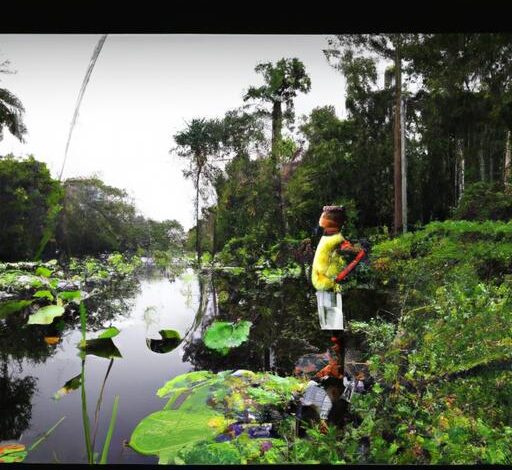Video One year-old boy eaten by crocodile sin censura

Introduction
In a tragic incident that sent shockwaves across the world, a one-year-old boy was fatally attacked and eaten by a crocodile. This heart-wrenching event brings to light the importance of understanding the dangers posed by wild animals and the need for enhanced safety measures. In this article, we delve into the incident, examine the contributing factors, explore the behavior of crocodiles, discuss the response and consequences, and draw valuable lessons from this unfortunate event.
Understanding the Incident
Details of the Tragedy
The incident unfolded in a remote location where a family was visiting a crocodile-infested area. Despite the vigilance of the parents, the young boy inadvertently strayed too close to the water’s edge, leading to the swift and fatal attack by the lurking crocodile. The horrifying incident serves as a reminder of the potential dangers associated with wildlife encounters.
Circumstances Leading Up to the Incident
While the incident itself is deeply tragic, it is important to examine the circumstances that led to the boy’s proximity to the crocodile. Understanding the factors at play can help prevent similar incidents in the future. Whether it was a lapse in parental supervision or inadequate safety precautions in the area, investigating these aspects can shed light on the preventable nature of the incident.
Location of the Incident
The incident occurred in a region known for its crocodile population. The lush surroundings and proximity to water bodies make it an ideal habitat for these reptiles. It is crucial to be aware of such locations and exercise caution when visiting areas with known wildlife activity.
Factors Contributing to the Tragedy
Proximity to the Crocodile
One of the primary factors contributing to this tragedy is the boy’s proximity to the crocodile. While the circumstances leading to this proximity are under investigation, it is essential to emphasize the importance of maintaining a safe distance from wild animals, particularly in their natural habitats.
Parental Supervision and Responsibility
Another crucial aspect to consider is the role of parental supervision and responsibility in preventing such incidents. Parents play a vital role in ensuring the safety of their children, especially in environments where potential dangers lurk. This incident serves as a reminder of the need for constant vigilance and adherence to safety guidelines.
Lapses in Safety Measures
Examining any lapses in safety measures at the location is imperative to prevent similar incidents in the future. Adequate signage, barriers, and warning systems can significantly reduce the likelihood of accidental encounters between humans and wildlife. Identifying any shortcomings in safety protocols can lead to implementing necessary improvements to safeguard visitors.
Crocodile Attacks and Human Encounters
History of Crocodile Attacks
Crocodile attacks on humans have been documented throughout history. These incidents serve as a stark reminder of the inherent risks associated with interacting with these powerful predators. Understanding the patterns and prevalence of such attacks can help individuals make informed decisions when venturing into crocodile habitats.
Behavior and Characteristics of Crocodiles
Crocodiles are formidable creatures with unique behaviors and characteristics that make them efficient hunters. Their ability to remain camouflaged and strike with incredible speed makes them highly dangerous. By understanding their behavior, individuals can take appropriate precautions to minimize the risk of encountering these apex predators.
Preventing Crocodile Attacks
Prevention is key when it comes to avoiding crocodile attacks. Educating the public about the potential dangers and providing guidelines on how to behave in crocodile habitats is essential. Simple measures like maintaining a safe distance, refraining from swimming in unknown waters, and respecting warning signs can significantly reduce the likelihood of a dangerous encounter.
Response and Consequences
Immediate Response to the Incident
Following the tragic incident, immediate response efforts were initiated to search for the young boy’s remains and ensure the safety of others in the area. Emergency services, wildlife officials, and local communities rallied together to address the situation promptly. The response serves as a testament to the collective effort in times of crisis.
Emotional and Psychological Impact
The emotional and psychological impact on the family cannot be understated. Losing a loved one under such harrowing circumstances leaves deep scars and requires extensive support and counseling. It is crucial to acknowledge the long-lasting effects of such tragedies and provide the necessary resources to assist those affected in coping and healing.
Legal Actions and Consequences
In the aftermath of the incident, legal actions and consequences may unfold. Investigations into the safety measures, potential negligence, or any other factors that contributed to the tragedy may lead to legal proceedings. Holding accountable those responsible for ensuring public safety can serve as a deterrent and prompt improvements in safety protocols.
Lessons Learned and Awareness
Raising Awareness about Wildlife Safety
The incident highlights the paramount importance of raising awareness about wildlife safety. Educating the public, particularly parents, about the potential risks and precautions when visiting areas inhabited by dangerous animals is crucial. By spreading awareness, we can empower individuals with the knowledge needed to protect themselves and their loved ones.
Enhancing Safety Measures
The tragic incident underscores the need for enhanced safety measures in areas with crocodile habitats. This includes implementing robust warning systems, clear signage, and physical barriers to prevent unintended encounters. By prioritizing safety precautions, we can minimize the chances of similar incidents occurring in the future.
Parental Education and Responsibility
Parents play a pivotal role in safeguarding their children from potential dangers. Educating parents about wildlife safety, including the risks associated with certain environments and the importance of constant supervision, is key. By promoting parental responsibility and knowledge, we can create a safer environment for children to explore and enjoy nature.
Conclusion
The heartbreaking incident involving a one-year-old boy and a crocodile serves as a somber reminder of the inherent risks of interacting with wildlife. Understanding the factors that contributed to this tragedy, learning from past incidents, and taking appropriate precautions can help prevent similar occurrences in the future. By raising awareness, enhancing safety measures, and promoting parental responsibility, we can create a world where both humans and wildlife coexist harmoniously. Let us strive to protect ourselves and the natural world we share.






